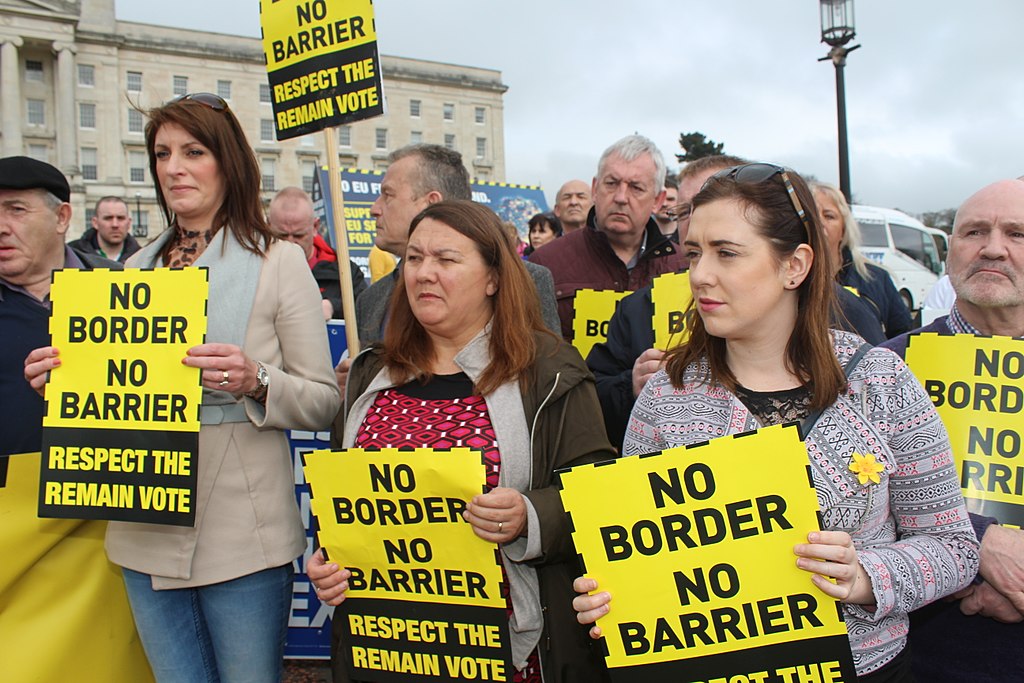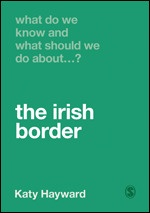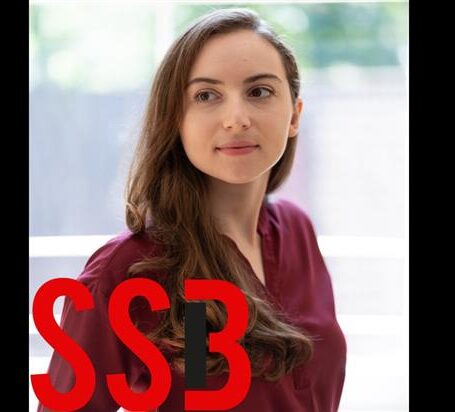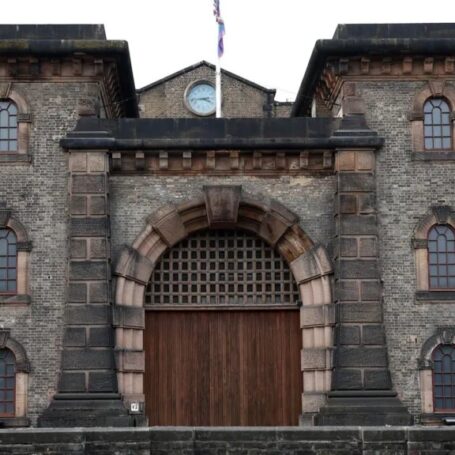A Social Scientist Looks at the Irish Border and Its Future

One of the flash points in the 5-year saga of Britain’s messy exit from the European Union was the island nation’s only substantial land border, the 500-kilometer line separating the six counties of Northern Ireland from the Republic of Ireland to the west and south. The potential hardening of the border, after years of frictionless passage — and which in turn followed the militarized border of ‘the Troubles’ era — created ample drama but ultimately did not scupper Brexit. What Do We Know and What Should We Do About the Irish Border? is a new book from Katy Hayward that applies social science to the existing issues and what they portend. (The book is published by SAGE, the parent of Social Science Space.)
Hayward, professor of political sociology in Queen’s University Belfast, is particularly well placed to synthesize and expand ‘what we know.’ She leads ‘The future and status of Northern Ireland after Brexit’ project as a senior fellow with the UK in a Changing Europe think-tank; has written a series of research reports for the Irish Central Border Area Network on the impact of the UK-EU negotiations on the border region; and served on the technical expert panel of the UK government’s Alternative Arrangements Advisory Group on Brexit. Hayward is also well-placed to communicate her scholarship: In 2019 she was named Political Studies Communicator of the year by the Political Studies Association and her Twitter account (@hayward_katy) received a special award from the Ewart-Biggs Memorial Prize in 2020 for illuminating and explaining the implications of Brexit for the island of Ireland.
We asked Hayward a few questions about what it takes to study issues like the Irish border and what we might expect to see centered on the border in the coming years.

Katy, could you tells us a little about your background and how you came to this issue (and this book)?
I completed my undergraduate degree in Peace and Conflict Studies at Magee College in Derry/Londonderry in the late 1990s, during which time the Good Friday (Belfast) Agreement was signed. The largest nationalist and unionist parties at the time, leading the way in the peace negotiations, were the SDLP and the Ulster Unionist Party. John Hume, leader of the SDLP and proud Derryman, frequently pointed to the importance of the European Union as a model for reconciliation and cooperation across borders. Inspired by this, but also wanting to put it to the test, I went on to University College Dublin for a PhD exploring how Irish nationalism had been changed by European integration, and how this related to peace. The Irish border was at the heart of all this, both in symbolism and practice.
Over the years that followed, I found myself researching a border that was one of the most open in the world, but nevertheless remained the touchstone for political identity and contestation in Northern Ireland. It was inevitable that the UK leaving the EU would bring the symbolism and practical significance of the Irish border to the fore. This book is an opportunity to explain why and how. It is also a chance to outline what should be borne in mind when considering what it all might mean.
What is it like being an academic whose studies focus on contentious issues? (Of course many study areas have people with strong opinions, but they’re not usually armed.) Do you have anecdotes that stand out? And do you expect to make any friends with this book?
Teaching on conflict, identity and social issues in Northern Ireland means that I am quite used to treading on ground that many would be wary of going near. I like teaching on these matters because I think it is possible to defuse the power that they have to raise tension and fear (especially in a ‘post-conflict’, divided society) by treating them as subjects of social science that are not exceptional or illogical, even if they are complex. It is possible to equip people to distinguish strong from poor evidence and reasoning; such skills are essential to good democracy, and are thus particularly valuable in times and places like these.
Talking about Brexit, borders and Northern Ireland is a triple-whammy of contentiousness, and I don’t expect to make any friends with this book! I tried to be as fair as possible to the views of unionists and nationalists, which means that I will inevitably irritate some people on both sides. The upside of that is that I will also have things to learn from their reactions, and thus, I hope, have a deeper understanding and greater awareness of the complexity of the subject in the future. That’s the best that any academic can ask for!
What does social science bring to the table in understanding the issues and, perhaps most importantly making decision and acting on them, in this dispute? And the next one, wherever and whenever it arises?
I hope that social science brings several things to help understand the issues. The first is evidence – and different types of it, too. Evidence about how borders function; evidence about how borders connect (or not) to policy and identity; evidence that seems to go against the dominant narratives and commonly-assumed facts. The second is an ability to identify and understand social responses to that evidence – both positive and negative. The third is an appreciation of the structures, institutions, policies and public discourses that can shape whether social responses are positive or negative. And the fourth is comparative analysis – lessons from elsewhere, lessons from history – that can give some indication, at the very least, of what not to do!
What does the book tell us about Brexit and border dispute that a careful news consumer wouldn’t have picked up?
I really appreciated the structure that I had to follow for this book as part of the ‘What do we know and what should we do about…’ SAGE series. This, plus its strictly tight word limit, pushes the author to set aside a lot of what would typically expect to be included in a book on the topic, and instead to concentrate on applying their knowledge in the most constructive way possible. Chris Grey, the series editor, allowed me a longer space in this book to cover the ‘Background’ chapter, which I wrote conscious of the ‘Irish Sea border’ as well as the Irish land border. As such, I hope that the ‘unique circumstances on the island of Ireland’ (to quote the Protocol on Ireland/Northern Ireland) can be illuminated in some way – including ‘Britishness’ as well as ‘Irishness.’
From that basis, the next chapter on ‘What do we know about the Irish border’ enabled me to draw out lessons from history as well as from the discipline of border studies and social science research in Ireland. And the chapter ‘What should we do about the Irish border’ speaks very much to the matters that are live in political debate today, such as the Protocol on Ireland/Northern Ireland and GB-to-NI trade, the potential for a border poll, the grassroots of cross-border cooperation.
How much is the Irish border dispute a dispute about the people and policies at the Irish border, and how much is it just a handy cudgel for pursuing broader political arguments? (And if the latter, what are those issues – Brexit itself, the Troubles, creation of the Republic, colonialism, etc.?)
I hope you don’t mind, but this is such a HUGE question, I don’t feel able to answer it in a short paragraph! I’d probably just ask the reader to complete the book then make up their mind for themselves as to what the dispute is about and the degree to which it is manipulated, exploited and flogged for political ends that may not be generally concerned with the common good.
The book is What Do We Know about the Irish Border. What don’t we know?
I was writing this book as a social scientist, and there is a wealth of knowledge about the Irish border that I was not even able to touch upon – knowledge from folklore, archaeology, geology, literature, and the Irish language, to name but a few. I am very conscious of that. And there was much that we know from social science and humanities that I wasn’t able to include – knowledge from demography, economics, law and anthropology, for example. I am conscious of that, too.
But if you push me to answer ‘What don’t we know’, I would be compelled to focus my answer on what would seem to have most relevance fairly soon. That is to say, we don’t know the degree to which the newly hardened post-Brexit Irish border for the movement of services and people (specifically non-Irish EU citizens) will affect economy, politics and identity north and south on the island of Ireland. Similarly, we don’t know whether the new Irish sea border will grow in significance over time. Even more importantly, we don’t know the nature of the new post-Brexit UK-EU relationship (which admittedly hasn’t really got off on the right foot) or how that will affect the conditions for the 1998 Agreement, i.e. British-Irish relations and north/south relations, or the operation of the Protocol. We can’t tell whether this UK-EU relationship will change considerably in the short to medium term, if there were to be, for example, a change of government in the UK. But what we do know (drawing on lessons from the partition of the island of Ireland), is that bad habits can be formed early on and become influential and difficult to shift. We also know from history that opportunities for a better outcome can be easily missed, and that the chances of this happening are made all the higher for as long as Northern Ireland is a topic of contention between the UK and the EU.
It’s just under a hundred years since independence and we’re where we’re at – for the Republic and the six counties, for the UK, for Europe. Where will we be in 2121?
The degree to which the experiences and conditions surrounding decision-making over the Irish border in 1921 mirror those of 2021 and the Irish sea border is really remarkable. In the Government of Ireland Act (1920), David Lloyd George drew a border across Ireland, which was, at the time, integrated as a whole within the United Kingdom. One hundred years later, in the Withdrawal Agreement Act of 2020, Boris Johnson chose to draw a different border down the Irish Sea, within the United Kingdom of Great Britain and Northern Ireland. Both Prime Ministers sought to manage an extremely complicated situation in a pragmatic way; but, of course, drawing a border is never a mere act of practicality. By 2121, I suspect that the consensus will be that the Withdrawal Agreement (containing the Protocol) was a UK Government decision that was highly significant for the island of Ireland as a whole.
More generally, in 2121, the concepts of ‘territory’, ‘collective identity’ and ‘polity’ will still be important in social science and public imaginations, but differently understood. Maybe an ecological lens will surely be more prevalent than it is today, and probably more important than the lenses of nationhood or sovereignty. Indeed, the population of the island of Ireland is likely to be larger and more diverse in 2121 than it is today, and so concepts of ‘nationhood’ and ‘sovereignty’ may seem quite outmoded by then. I would place a bet, though, that the topic of borders won’t be!































































































